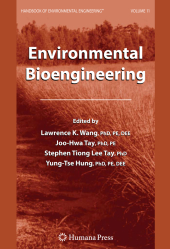 Neuerscheinungen 2016Stand: 2020-02-01 |
Schnellsuche
ISBN/Stichwort/Autor
|
Herderstraße 10
10625 Berlin
Tel.: 030 315 714 16
Fax 030 315 714 14
info@buchspektrum.de |

Yung-Tse Hung, Joo-Hwa Tay, Stephen Tiong Lee Tay, Lawrence K. Wang
(Beteiligte)
Environmental Bioengineering
Volume 11
Herausgegeben von Wang, Lawrence K.; Tay, Joo-Hwa; Tay, Stephen Tiong Lee; Hung, Yung-Tse
Softcover reprint of the original 1st ed. 2010. 2016. xxviii, 867 S. 201 Tabellen. 254 mm
Verlag/Jahr: SPRINGER, BERLIN; HUMANA PRESS 2016
ISBN: 1-493-95671-X (149395671X)
Neue ISBN: 978-1-493-95671-5 (9781493956715)
Preis und Lieferzeit: Bitte klicken
The impact of pollution on the environment has emerged as a particularly critical area of research in recent years. This handbook is a collection of methodologies that study the effects of pollution and waste in their three basic forms: gas, solid, and liquid.
The past 30 years have seen the emergence of a growing desire worldwide that positive actions be taken to restore and protect the environment from the degrading effects of all forms of pollution - air, water, soil, and noise. Since pollution is a direct or indirect consequence of waste production, the seemingly idealistic demand for "zero discharge" can be construed as an unrealistic demand for zero waste. However, as long as waste continues to exist, we can only attempt to abate the subsequent pollution by converting it to a less noxious form. Three major questions usually arise when a particular type of pollution has been identi ed: (1) How serious is the pollution? (2) Is the technology to abate it available? and (3) Do the costs of abatement justify the degree of abatement achieved? This book is one of the volumes of the Handbook of Environmental Engineering series. The principal intention of this series is to help readers formulate answers to the above three questions. The traditional approach of applying tried-and-true solutions to speci c pollution problems has been a major contributing factor to the success of environmental engineering, and has accounted in large measure for the establishment of a "methodology of pollution control. " However, the realization of the ever-increasing complexity and interrelated nature of current environmental problems renders it imperative that intelligent planning of pollution abatement systems be undertaken.


